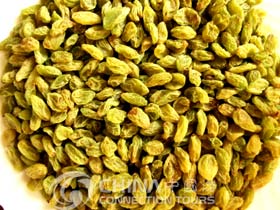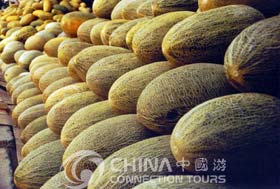
Xinjiang is known as the "home of fruits and melons." Apricots, cantaloupe, and pomegranates are heaped in local bazaars next to bins of saffron tea and walnuts, and are sent to other markets throughout China as well as other parts of the world. Yet, the raisin gets lauded even against the very stiff local competition.
 Raisins
Raisins
The raisin, a wrinkly translucent fruit, is a 2,000-year-old snack in Northwest China's Xinjiang Uygur Autonomous Region, a dessert in the desert. Known as the "green pearl" of West China, it is a cheap delicacy, and an everyman's staple. The dried green pearl retains its taste longer in an exposed outdoor market than do vacuum-packed moist raisins.
In Turpan, a combination of low-lying lands, long hours of sunshine, cool nights and hot days produce a seedless white grape inordinately sugary when harvested in August. Forty days after being plucked from the trellises (wooden fences supporting the grapevines) and dried in adobe houses, the green-pearl raisin is ready for shipment to other parts of China as well as all over the world.
The raisins are rich in natural fructose, protein, vitamin, cellulose and various microelements, with no additives and pigments. They are healthy food that can be used to help treat cancer.
The seedless white grapes produced in Xinjiang are ovoid, crystal-clear, crisp, and juicy, with a thin skin. Fresh grapes contain more than 24 percent of sugar, while raisins contain 75 to 80 percent sugar. Seedless white grapes are not subject to plant diseases and insect pests, so farmers do not need to spray pesticides on them. Both fresh and dried grapes are natural green fruit.
 Melons
Melons
The sweet and tasty Hami melons are known as the "king of melons." They are grown in the Tarim, Junggar and Turpan basins, and the Hami Prefecture. This melon came originally from nearby Shanshan, but is named for King Hami who once sent these melons to a Qing (1644-1911) emperor as a tribute.
There are more than 180 varieties of Hami melons in different shapes, sizes, and flesh colors. Sizes range from as large as a cannonball of over a dozen kilograms to as small as a coconut. They are mainly oval in shape and come in yellow, green, brown and white, with various dapples (color patches).
Hami melons are not only delicious, but also rich in nutrition. One melon contains four to seven times more vitamins than watermelons, six times more than apples, and 1.3 times more than apricots. A Hami melon can allay a fever and dispel the heat, so it is a healthy choice on hot summer days. It is reputed to cure or alleviate a number of diseases, ranging from stomach problems to anemia.
Xinjiang Milk Tea
If you visit Xinjiang, the hospitable hosts will welcome you with savory milk tea. Milk tea is such an essential drink that the local people would prefer having no food to having no milk tea. It is not without reason that milk tea is a daily drink among the minority peoples in Northwest China's Xinjiang Uygur Autonomous Region. In such a pasture area that is high in altitude and cold in temperature, a lot of meat with comparatively few vegetables is eaten. People in this area drink milk tea for the additional minerals it adds to their diet and to help with their digestion. The special drink helps them drive away cold in winter and heat in summer.
Milk tea is prepared by breaking the tea (which comes in dry hard blocks) into pieces and boiling it in a copper pot. Pour milk into the tea when it is boiling and then add some salt before drinking. The tea is best when drunk immediately after preparation.
Rice Eaten with Hands
Shou Zhua Fan, or "rice eaten with hands," is another special Xinjiang recipe. This dish is made of rice cooked with fresh mutton, carrots, onions, vegetable oil, melted sheep's fat, and raisins. It is eaten without benefit of utensils, hence the name Shou Zhua Fan.
There are more than 10 varieties of this rice dish. The most common one uses mutton as the main ingredient, but there is also chicken. The dish is soft, delicious and nutritious. Shou Zhua Fan is not only a kind of well-nourishing cuisine, but also a feature of festivals, funerals, and weddings.
Since to cook one pot of the mixed rice takes six hours, at restaurants it is usually cooked early in the morning, and heated by microwave oven whenever ordered. Hence, the chewy texture and some of the taste might not be as good.
Almond
The almond is one of the most treasured dried fruit of the Uygur people. It is actually not a nut, but a plant of the almond tree subgenus in the peach genus. Its nutrition is many times higher than that of beef of the same weight. A kernel typically contains vegetable oil (55-61 percent), protein (28 percent), and amylum (a complex starch) and sugar (10-11 percent), as well as vitamins and 18 trace elements.
The Almond has more than 40 varieties of 5 families in Northwest China's Xinjiang Uygur Autonomous area. Better almonds can be made into relieving medicine that can make it easier to expel phlegm from the chest or lungs, exert a restorative influence on the intestines, and improve bowel movement.
The almond is also often used to cure diseases like hypertension, neurasthenic (general listlessness and so on), hypersensitive skin, tracheitis (windpipe inflammation), and infantile rickets.
In short, the almond, with its tonic effect, is the best choice for the Uygurs to keep healthy.
In addition, almonds can also be pressed into almond oil and used as an industrial product.
Xinjiang sweet almonds are the traditional product for export and an indispensable material from which almond tea, almond icing, and almond chocolate are made.
Shish Kebab
Xinjiang Shish Kebab is as famous as the roast duck of Beijing. It is a popular snack nationwide -- found in the streets and bazaars throughout China, and a lot of people like it very much.
As the most famous of Xinjiang snacks, shish kebabs are chunks of fatty and lean lamb meat skewered on a wooden stick and roasted over charcoal. The kebabs are turned continually, and when they are almost done, salt, pepper, and other seasonings are sprinkled on them. Kebabs are crispy outside and tender inside, and slightly salty and hot with their peculiarly strong flavor of Ziran (a kind of aniseed). They are not greasy and have no unpleasant smell.
There are two reasons why shish kebab is so delicious. One is because of the excellent Xinjiang mutton; the other is because of the special spice. The fuels used are always blind coal and firewood. Nowadays, there is a kind of oven that is healthier and more economic, convenient.
When in Xinjiang , it is a pity if you do not have a taste of shish kebab.
Nang
Nang, or pancake, is a daily staple food for the Uygurs, just like steamed bread in northern China and rice in the south. It has a history of more than 2,000 years, with over 50 varieties.
Making a nang is similar to making a pancake. The materials include wheat flour, corn flour, or sorghum flour, with such seasonings as sesame seeds, onions, eggs, vegetable oil, butter, milk, salt, and sugar. When the surface turns golden yellow, the crispy and delicious nangs are done.
It is invariable round in shape, but there are about fifty different kinds of nang. The most common is meat nang.

